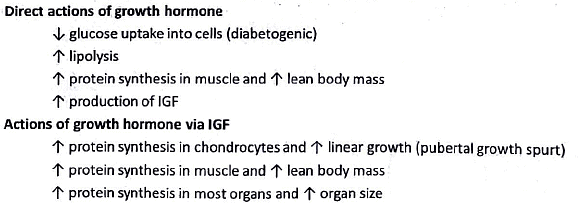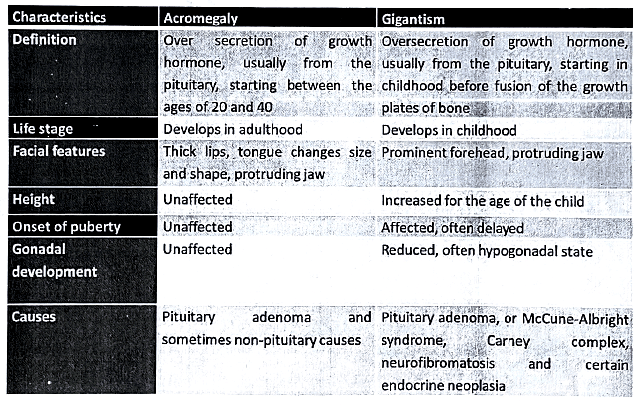Pituitary gland | Medical Science Optional Notes for UPSC PDF Download
Pituitary gland
Anterior pituitary gland
The anterior pituitary secretes six hormones: adrenocorticotropic hormone (corticotropin, ACTH), thyroid- stim ulating hormone (thyrotropin, T S H ) , growth h o rm o n e , follicle stim ulating hormone (FSH), luteinizing hormone (LH), and prolactin (PRL). An additional polypeptide, p-lipotropin (P- LPH), is secreted with ACTH, but its physiologic role is unknown.

The given information outlines the specific actions of different hormones on their target glands or tissues:
ACTH (Adrenocorticotropic Hormone):
- Stimulation: ACTH stimulates the adrenal gland.
- Target: Adrenal gland.
- Action: Induces the release of cortisol.
TSH (Thyroid-Stimulating Hormone):
- Stimulation: TSH stimulates the thyroid gland.
- Target: Thyroid gland.
- Action: Promotes the release of thyroid hormones T3 (triiodothyronine) and T4 (thyroxine).
Prolactin:
- Stimulation: Prolactin has a role in lactogenesis.
- Target: Mammary glands.
- Action: Facilitates milk production in mammary glands.
GH (Growth Hormone):
- Stimulation: GH stimulates the release of insulin-like growth factor (IGF) from the liver.
- Target: Liver.
- Action: Induces the release of IGF, which plays a key role in growth and development.
FSH (Follicle-Stimulating Hormone) / LH (Luteinizing Hormone):
- Stimulation: FSH and LH stimulate the release of estrogen and testosterone.
- Target: Ovaries in females (estrogen), testes in males (testosterone).
- Action: Promotes the development of ovarian follicles and the production of estrogen in females, and stimulates testosterone production in males.
These hormones play essential roles in regulating various physiological processes, including the function of target glands, growth, reproduction, and metabolism. The percentages provided suggest the approximate distribution of these hormones' actions in their respective functions.
Adrenal gland
Adrenocortical secretion is controlled primarily by adrenocorticotropic hormone (ACTH) from the anterior pituitary, but mineralocorticoid secretion is also subject to independent control by circulating factors, of which the most important is angiotensin II, a peptide formed in the bloodstream by the action of renin.

Cushing Syndrome
While the term "Cushing's syndrome" can be applied to any cause of hypercortisolism, "Cushing's disease" refers specifically to secondary hypercortisolism that results from excessive production of ACTH by pituitary adenomas.

Growth Hormone
Biosynthesis:
- The gene hGH-N, located on chromosome 17, codes for the normal form of growth hormone.
- Synthesized and secreted by the pituitary gland.
- Undergoes various posttranslational modifications.
Structure:
- The structure of growth hormone varies among different species.
Circulation and Forms:
- Approximately 50% of the circulating growth hormone is in a bound form.
- The basal level of growth hormone is typically less than 3 ng/mL.
- The half-life of circulating growth hormone in humans is 6-20 minutes.
Mechanism of Action:
- The growth hormone receptor belongs to the cytokine receptor superfamily.
- Dimerization of the receptor is essential for activation.
- Activates the JAK2-STAT pathway.
- JAK2 (Janus kinase 2) is a member of the Janus family of cytoplasmic tyrosine kinases.
- STATs (Signal Transducers and Activators of Transcription) are cytoplasmic transcription factors that, upon phosphorylation by JAK kinases, migrate to the nucleus and activate various genes.
Functions/Effects:
- Stimulates growth, particularly in bones and cartilage.
- Promotes protein synthesis and cell division.
- Enhances the breakdown of fats, releasing energy.
- Plays a role in regulating metabolism.
Regulation:
- Regulated by various factors, including growth hormone-releasing hormone (GHRH) and somatostatin.
- Release is pulsatile, with higher levels during sleep and after exercise.
- Influenced by factors such as stress, nutrition, and blood sugar levels.
Gigantism/Acromegaly:
- Gigantism: Excessive growth in childhood due to an overproduction of growth hormone.
- Acromegaly: Excessive growth in adulthood, characterized by enlargement of bones in the face, hands, and feet.
- Typically caused by a benign tumor of the pituitary gland, leading to increased growth hormone production.
Understanding the biosynthesis, mechanism of action, functions, and regulation of growth hormone is crucial for comprehending its role in growth and metabolism, as well as the disorders associated with its dysregulation.
Actions
Growth hormone generates the production of somatomedins by liver (insulin-like growth factors fIGFl), which serve as the intermediaries of several physiologic actions.
The IGF receptor has tyrosine kinase activity, similar to the insulin receptor.

Regulation
Growth hormone is released in pulsatile fashion.

Regulation
- Hypothalamic control—GHRH and somatostatin
- GHRH stimulates the synthesis and secretion of growth hormone. Somatostatin inhibits secretion of growth hormone by blocking the response of the anterior pituitary to GHRH.
- Negative feedback control by somatomedins (Insulin like growth factors)
- Somatomedins are produced when growth hormone acts on target tissues. Somatomedins inhibit the secretion of growth hormone by acting directly on the anterior pituitary and by stimulating the secretion of somatostatin from the hypothalamus.

Growth hormone
- Negative feedback control by GHRH and growth hormone
- GHRH inhibits its own secretion from the hypothalamus.
- Growth hormone also inhibits its own secretion by stimulating the secretion of somatostatin from the hypothalamus.
Deficiency (DWARFISM)
In children causes failure to grow, short stature, mild obesity, and delayed puberty.
Causes
- Hypothalamic pituitary axis
- Lack of anterior pituitary growth hormone
- Hypothalamic dysfunction (↓GHRH)
- Failure to generate IGF in the liver
- Growth hormone receptor insensivity (Laron dwarfism)
- Non pituitary causes Child hood hypothyroidism (Cretinism)
- Precocious puberty
- Gonadal dysgenesis
- Constitutional Chronic abuse and neglect (Psychosocial dwarfism/Kasper hauser syndrome)
- Achondroplasia (FGFR3 mutation)
GH deficiency-Recombinant forms of growth hormone and IGF-1

Excess
Pituitary adenoma -> Large amounts of GH -> Gigantism (Children) and Acromegaly (Adults)
Therapy
- Use of somatostatin analogues (Octeotride, lanreotide)
- Growth hormone receptor antagonists (Pegvisomant)
- Dopamine agonists (Bromocriptine and cabergoline)
- Surgical removal of pituitary tumor (Transsphenoidal surgical resection)
 |
Download the notes
Pituitary gland
|
Download as PDF |
Prolactin
It is structurally homologous to growth hormone.
Actions of prolactin
- Stimulates milk production in the breast (casein, lactalbumin)
- Stimulates breast development (in a supportive role with estrogen)
- Inhibits ovulation by decreasing synthesis and release of gonadotropin-releasing hormone (GnRH)
- Inhibits spermatogenesis (by decreasing GnRH)

Regulation of prolactin
- Hypothalamic control by dopamine and thyrotropin-releasing hormone (TRH)
- Prolactin secretion is tonically inhibited by dopamine (prolactin-inhibiting factor [PIF]) secreted by the hypothalamus. Thus, interruption of the hypothalamic-pituitary tract causes increased secretion of prolactin and sustained lactation.
- TRH increases prolactin secretion.
- Negative feedback control
- Prolactin inhibits its own secretion by stimulating the hypothalamic release of dopamine.

- Prolactin inhibits its own secretion by stimulating the hypothalamic release of dopamine.
|
7 videos|219 docs
|
FAQs on Pituitary gland - Medical Science Optional Notes for UPSC
| 1. What is the function of the pituitary gland? |  |
| 2. What is Cushing Syndrome? |  |
| 3. How does the pituitary gland contribute to Cushing Syndrome? |  |
| 4. What are the symptoms of excessive growth hormone secretion? |  |
| 5. How is excess growth hormone secretion diagnosed and treated? |  |






















